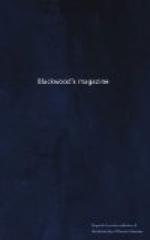It is time, indeed, that we ourselves turned to this work, the perusal of which has led us to these remarks upon Mr Carlyle. We were desirous, however, of forming something like a general estimate of his merits and demerits before we entered upon any account of his last production. What space we have remaining shall be devoted to this work.
Past and Present, if it does not enhance, ought not, we think, to diminish from the reputation of its author; but as a mannerism becomes increasingly disagreeable by repetition, we suspect that, without having less merit, this work will have less popularity than its predecessors. The style is the same “motley wear,” and has the same jerking movement—seems at times a thing of shreds and patches hung on wires—and is so full of brief allusions to his own previous writings, that to a reader unacquainted with these it would be scarce intelligible. With all this it has the same vigour, and produces the same vivid impression that always attends upon his writings. Here, as elsewhere, he pursues his author-craft with a right noble and independent spirit, striking manifestly for truth, and for no other cause; and here also, as elsewhere, he leaves his side unguarded, open to unavoidable attack, so that the most blundering critic cannot fail to hit right, and the most friendly cannot spare.
The past is represented by a certain Abbot Samson, and his abbey of St Edmunds, whose life and conversation are drawn from the chronicle already alluded to, and which has been lately published by the Camden Society.[68] Our author will look, he tells us, face to face on this remote period, “in hope of perhaps illustrating our own poor century thereby.” Very good. To get a station in the past, and therefrom view the present, is no ill-devised scheme. But Abbot Samson and his monks form a very limited, almost a domestic picture, which supplies but few points of contrast or similitude with our “own poor century,” which, at all events, is very rich in point of view. When, therefore, he proceeds to discuss the world-wide topics of our own times, we soon lose all memory of the Abbot and his monastery, who seems indeed to have as little connexion with the difficulties of our position, as the statues of Gog and Magog in Guildhall with the decision of some election contest which is made to take place in their venerable presence. On one point only can any palpable contrast be exhibited, namely, between the religious spirit of his times and our own.
[Footnote 68: Chronica JOCELINI DE BRAKELONDA, de rebus gestis Samsonis Abbatis Monasterii Sancti Edmundi: nunc primum typis mandata, curante JOHANNE GOGE ROKEWOOD. (Camden Society, London, 1840.)]




